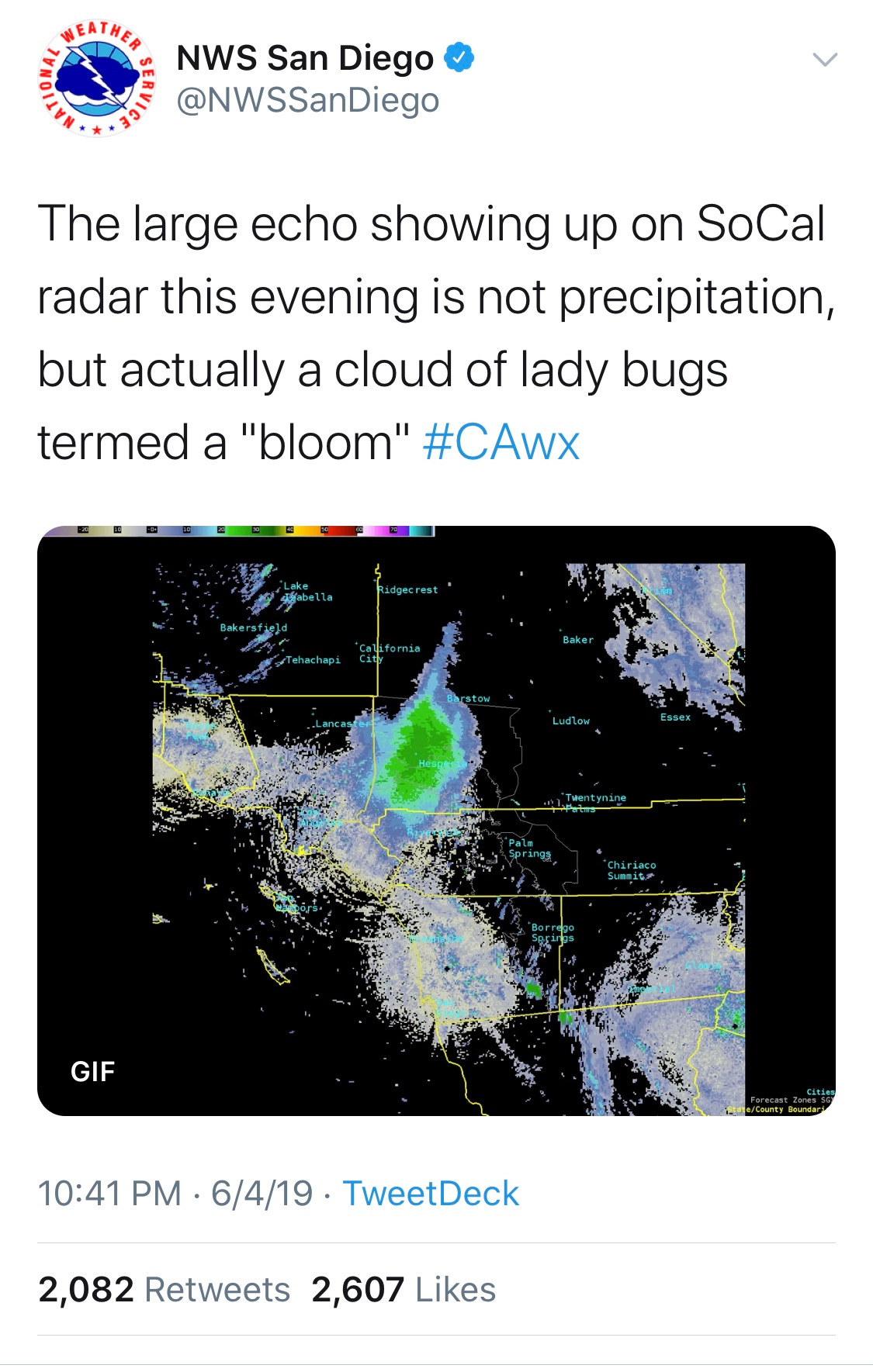Flight of the fire ants

“There is no such thing as an empty lot.” So baby and I learned yesterday, sneaking through this feral patch of industrial park. We are deeper in the field today, so this week’s report will be brief.
Thunderstorms blew in on Monday night, bringing us much-needed rain. When the storms began to clear Tuesday, strange clouds of a different sort started to appear on the weather radar, over the Interstate 35 corridor. The Austin/San Antonio office of the National Weather Service began to collect eyewitness reports of what appeared to be termites or grasshoppers. My friend Rob shared this Fortean outtake from the NWS page on his feed:

I re-shared it, and my friend Eric, a professional ecologist who is in charge of a major brownfield restoration project in East Austin (one I also work on) and spends most of his working life in the field, suggested the more likely explanation was a nuptial flight of fire ants, which occur this time of year, especially after a big morning rain event with clearing skies.
“Pretty cool and worrisome it was picked up on radar,” said Eric. “I feel the burn already.”
Yes, fire ants can fly. It’s how they reproduce, and spread. Here’s a fire ant queen preparing to take off on her nuptial flight, courtesy of the National Science Foundation’s report on the rapid genetic changes of which such ants are capable:

“Having mated once, and only once, while in flight, the females will alight, break off their wings, dig into the soil, and start laying eggs to found a new colony.” So explains writer Steven Austad in this excellent piece “In Praise of Fire Ants,” which also notes how the effort to eradicate fire ants through aerial spraying of herbicide was the principal cause of the avian holocaust described by Rachel Carson in her landmark “fable for tomorrow” Silent Spring. The fire ants, as anyone who has dealt with them in their yard will be unsurprised to hear, managed to increase their range by 50% during this “carpet bombing campaign.”
Austad also accurately notes that fire ants can make you boogie. It is rare that I am able to weed my yard without doing the fire ant boogie at least once, to the entertainment of my family. (Hard-earned pro tip for guys: always make sure you have gotten all the fire ants off your hands before you relieve yourself outdoors following a fire ant encounter.)
Biological emergences so massive they show up on the weather radar are always awesome, and it’s reassuring to know there are species that can still flourish in the urbanized environment enough to express like that. I have seen Biblical swarms of tarantulas in West Texas, so many on the roads that you can’t avoid running them over, but at least they can’t fly. Lady bugs can:

And so can bats. Near us at Bracken Cave, just off I-35 north of San Antonio (close to New Braunfels), we are lucky to have the world’s largest bat colony, home to 15 million Mexican free-tailed bats (the same species that lives under Austin’s Congress Avenue Bridge)—one of the largest concentration of mammals on Earth. Bat Conservation International bought the land in 1992, and has been acquiring neighboring parcels as it can, and fighting incompatible development around the site as the Austin-San Antonio growth sprawl tries to crowd the bats out.

Photo courtesy of Bat Conservation International
I’ve been down there to watch the emergence twice with my son, and it’s really astonishing. The cave is like a bubble of rock rising up out of the scrubby Hill Country landscape, and when you walk up around the eastern side there is an opening in the earth. As the sun begins to duck down, the bats start to peel of the walls, and for the next hour or two you can stand there as the swarm fills the air around your head, darting and dodging. When you get back in your car you smell like guano, and you don’t mind. Especially because you know the swarm is so big that the military jets from San Antonio’s Air Force bases have to fly around it.

Screen shot courtesy of Bat Conservation International
Bracken Cave is temporarily closed to visitors during the pandemic, but the Bat Conservation International website has regular updates, and is packed with information about the cave and urban bats generally.
Sunset in Dystopia

Yesterday evening, not long after we found a massive concentration of grackle nests in a patch of mesquite trees behind a truck stop, right next to a South Texas Tesla charging station, baby and I walked down to the beach. The Saharan dust cloud was evident all the way from Austin, and as the sun went down over the barrier island, above the Texas beach where you can drive your vehicle right up to the waterline, it looked like the matte-painted sky from some 70s sci-fi movie about the ozone future we now live in. But the breeze was up off the Gulf, and the pelicans looked pretty content as they drifted the afternoon thermals. As we walked back, we saw some gulls fighting over a piece of food trash behind a condo.
Back next week with a report on whether the Saharan dust cloud sunrises are as epic as predicted, and on what kind of wildlife you can find in saltwater inlets named after oilfield service companies.
In the meantime, here’s a little ambient video of the pink sky coming up earlier this week, as the acolytes of Vulcan practice their Promethean art in the dark. (Better with sound.)
Have a great week.

